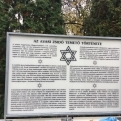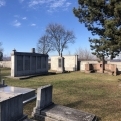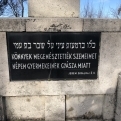Az avasi zsidó temető története - Holokauszt emlékmű
Town:
Miskolc, Hungary
Address:
3501 Miskolc, Mendikás dűlő
Set by:
Miskolci Zsidó Hitközség, 1970
Könnyek megemésztették szemeimet népem gyermekeinek gyásza miatt







The history of the monument
The presence of Jewish people in Hungary began in the 18th century.
Most of the Jewish people who settled in this country were artisans and
road-man. In the middle of the same century, 24 families moved to the
city of Miskolc. Thus, a significant number of Jewish people appeared in
the city, which led to the appearance of rabbis and teachers. By the
end of the 18th century, hundreds of Jews were present in the city.
As
a consequence of the rapid settlement of Jewish families in the city of
Miskolc, a Jewish cemetery was established. The setup of this graveyard
started with purchasing a site in 1759; this site was located in the
northwest side of Avas. It is safe to assume that the landlord easily
gave up the area since it was neither productive nor suitable for cellar
design. It is worth mentioning that the area was fenced after 55 years
prior to the cemetery purchase. In 1814, and due to the financial
support of Ónod, Solomon Klein, who was a Jewish resident of the city,
the area was kept secure. Solomon sacrificed all of his property to
retain that area of 5 hectares and 34 square meters secured. "The total
cost was 20 thousand HUF."
When the cemetery
was first opened, it had two main entrances. The first one was located
on the upper side of Avas, while the second one on the Rúzsin side,
accessing the cemetery back then required going through either these
entrances. A ceremonial building was built near the entrance on the
lower part, but it was rarely used. In 1987 the fence of the cemetery
was remade. As a result, the ceremonial building was demolished, and
both entrances were simultaneously closed. Two more entrances were made
after that, one on the east side next to the guardhouse, as the main
entrance, which is now the top of Avas (Avastető). The other one on the
south side, which is adjacent to today's Avas driveway. There is also a
ritual accessory on the east side entrance, also known as a kijor, which
includes a hand wash basin and a water measuring cup.
The
funeral begins at the main entrance, the southern gate, during which,
and according to tradition, the procession is followed by the bereaved,
led by a rabbi or a cantor. They stop praying several times during the
journey. The mourners are in separate groups, one composed of women and
the other composed of men. After the funeral, the mourners leave the
cemetery from the eastern gate.
The cemetery
has strict rules for graves: each grave must be six men's span distance
away from each other. Women and men were usually buried separately
(except for marriage), and a small path was placed between them,
indicating the border. However, due to the lack of space, graves of the
different genus were often mixed up. According to Jewish laws, graves do
not have an expiration; they are for forever. Looking at the
gravestones, it can be noticed that they were directed toward the east.
Moreover, the coffin containing the bodies of the dead has been placed
in the same manner. No significant difference between the gravestones
can be spotted, as its materials were used from the surrounding gravel
mines, such as the Bükkábrány and Bodrogkeresztúr stones.
The
sacred association of the Jewish cemetery, named after Chevra Kadisha
(Aramaic: חֶבְרָה קַדִישָא, Ḥebhra Qaddisha), was founded in 1769 in
Miskolc. It is one of the oldest institutions of Jewry, made up of women
and men. Their task is to bury dead Jewish people following Jewish
tradition. It is also responsible for the ancient and exact observance
of traditions and ceremonies, the operation of which is governed by the
Sulchan Áruh, the medieval codex. Chevra cannot be skipped off the
Jewish community because, without it, the community would not work.
After the appointment, The members of the association make a solemn vow
to observe the ritual rules and record their activities in the Chevra
Book.
The presence of Jewish people in Hungary began in the 18th century.
Most of the Jewish people who settled in this country were artisans and
road-man. In the middle of the same century, 24 families moved to the
city of Miskolc. Thus, a significant number of Jewish people appeared in
the city, which led to the appearance of rabbis and teachers. By the
end of the 18th century, hundreds of Jews were present in the city.
As
a consequence of the rapid settlement of Jewish families in the city of
Miskolc, a Jewish cemetery was established. The setup of this graveyard
started with purchasing a site in 1759; this site was located in the
northwest side of Avas. It is safe to assume that the landlord easily
gave up the area since it was neither productive nor suitable for cellar
design. It is worth mentioning that the area was fenced after 55 years
prior to the cemetery purchase. In 1814, and due to the financial
support of Ónod, Solomon Klein, who was a Jewish resident of the city,
the area was kept secure. Solomon sacrificed all of his property to
retain that area of 5 hectares and 34 square meters secured. "The total
cost was 20 thousand HUF."
When the cemetery
was first opened, it had two main entrances. The first one was located
on the upper side of Avas, while the second one on the Rúzsin side,
accessing the cemetery back then required going through either these
entrances. A ceremonial building was built near the entrance on the
lower part, but it was rarely used. In 1987 the fence of the cemetery
was remade. As a result, the ceremonial building was demolished, and
both entrances were simultaneously closed. Two more entrances were made
after that, one on the east side next to the guardhouse, as the main
entrance, which is now the top of Avas (Avastető). The other one on the
south side, which is adjacent to today's Avas driveway. There is also a
ritual accessory on the east side entrance, also known as a kijor, which
includes a hand wash basin and a water measuring cup.
The
funeral begins at the main entrance, the southern gate, during which,
and according to tradition, the procession is followed by the bereaved,
led by a rabbi or a cantor. They stop praying several times during the
journey. The mourners are in separate groups, one composed of women and
the other composed of men. After the funeral, the mourners leave the
cemetery from the eastern gate.
The cemetery
has strict rules for graves: each grave must be six men's span distance
away from each other. Women and men were usually buried separately
(except for marriage), and a small path was placed between them,
indicating the border. However, due to the lack of space, graves of the
different genus were often mixed up. According to Jewish laws, graves do
not have an expiration; they are for forever. Looking at the
gravestones, it can be noticed that they were directed toward the east.
Moreover, the coffin containing the bodies of the dead has been placed
in the same manner. No significant difference between the gravestones
can be spotted, as its materials were used from the surrounding gravel
mines, such as the Bükkábrány and Bodrogkeresztúr stones.
The
sacred association of the Jewish cemetery, named after Chevra Kadisha
(Aramaic: חֶבְרָה קַדִישָא, Ḥebhra Qaddisha), was founded in 1769 in
Miskolc. It is one of the oldest institutions of Jewry, made up of women
and men. Their task is to bury dead Jewish people following Jewish
tradition. It is also responsible for the ancient and exact observance
of traditions and ceremonies, the operation of which is governed by the
Sulchan Áruh, the medieval codex. Chevra cannot be skipped off the
Jewish community because, without it, the community would not work.
After the appointment, The members of the association make a solemn vow
to observe the ritual rules and record their activities in the Chevra
Book.
Who we remember


Mordechai Yaakov Gottlieb Chaim
(1876-1936)
Burning candles (0)
Extinguished candles (0)






















